June 4th, 2013
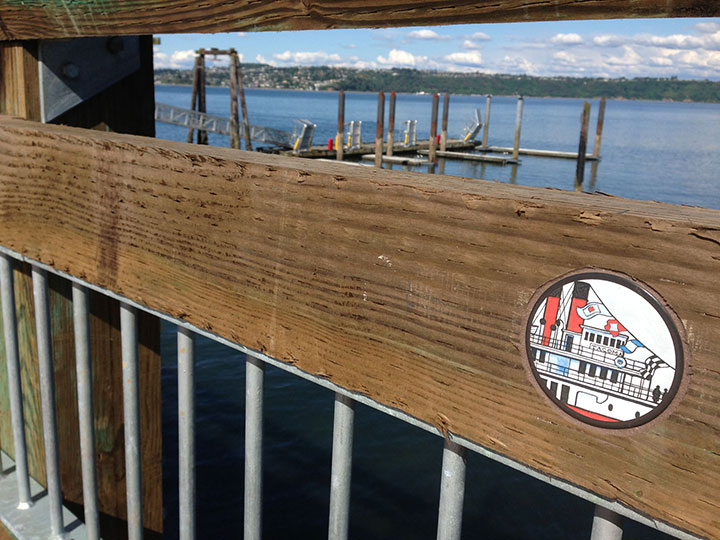
Public art is a funny thing. If I learned anything from my last public art project, it was that time moves differently in the public art realm. It takes so long for a project to go from blueprint to grand opening that the artwork can’t be considered “done” until months or sometimes years after the artist finishes the design. In this case, I’ve been sitting on this one for quite some time—so I’m pleased as punch that I can finally reveal a glimpse or two!
This is just one part of my new piece, Droplets, which is now a permanent part of the newly-restored Old Town Dock in Tacoma. Originally built in 1873, Old Town Dock is one of the city’s oldest properties, and was an important part of Tacoma’s shipping history. It served as a public walkway until 2008, just before I moved to town, when it was closed to the public due to structural concerns.
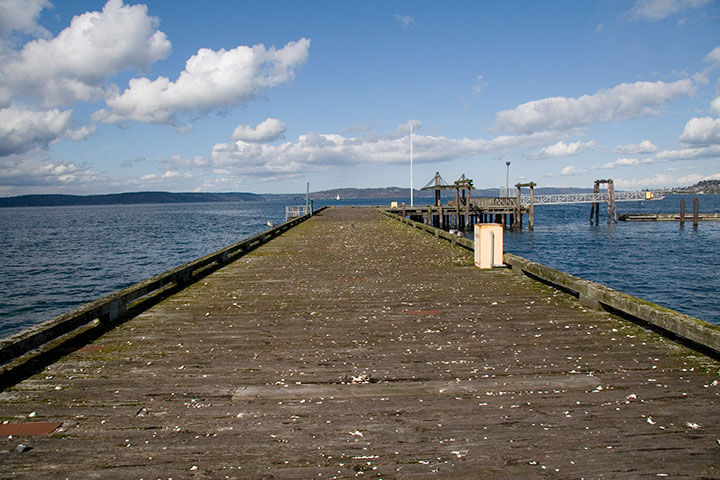
This is how the Dock looked two years ago, when I first toured the site as a finalist for the public art commission. The place was a mess, with rotting planks, makeshift barriers and caution tape roping off unstable (or even missing!) sections of the pier, and about forty frillion dead crabs, seashell fragments, and other seafood snacks the gulls would drop on the wood. You couldn’t walk a single step without hearing/feeling a disconcerting crunch underfoot.
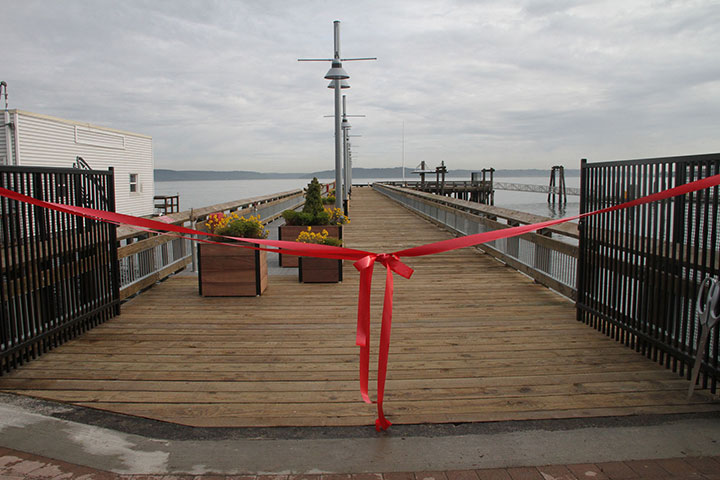
And here she is today, all shiny and new again. The City and Metro Parks Tacoma split the job of refurbishing the pier on its original footprint, adding benches and lampposts, and turning the place into a city park. And thanks to the One Percent for Art program, the project included funds for a public art commission.
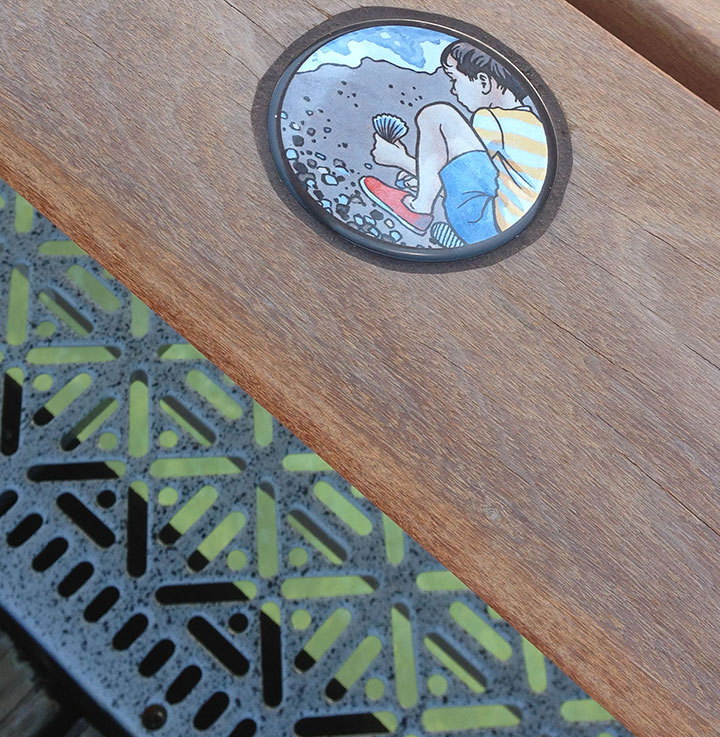
The artwork comes with a hitch, though: you have to find it first.
I’ll be sharing more about the project in the coming days, but I want to wait until after the public unveiling to do so. In the meantime, if you’re in the area, the Dock is actually open to the public already (we had a “soft opening” and ribbon-cutting a couple of weeks ago). But I’d recommend the main event, which is a week from Sunday (bring your dad!). Here’s the skinny:
Dad’s Day at Old Town Dock
Grand Reopening & Dedication of Public Artwork
Featuring music by Pearl Django
Sunday, June 16, 2013
11 am to 1 pm, free!
Ruston Way at McCarver Street, Tacoma, WA
Be there or be … er … round?
April 23rd, 2012
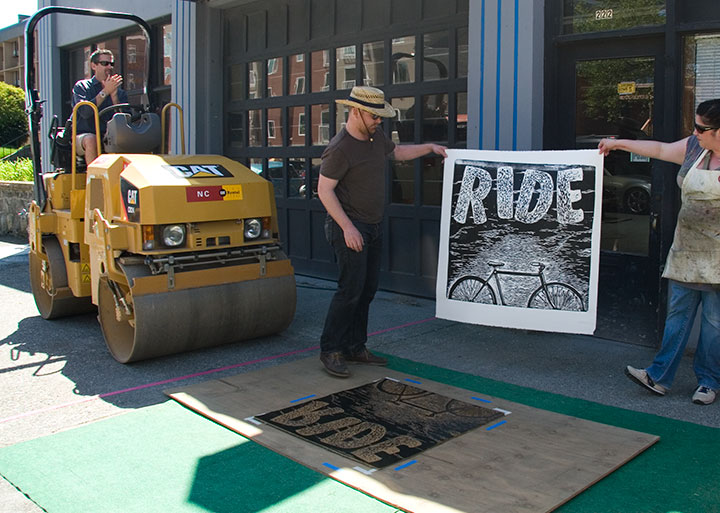
Oh, man. I’m beat. You people plum wore me out this time. Every year I keep thinking we can’t possibly top the previous one, but Wayzgoose just keeps getting better and better. And this year, the weather was so unbelievably good* that I think half of Tacoma (plus a good portion of Seattle and a smattering of Portland) put on their walking shoes and marched into our midst.
*See all those pairs of sunglasses? That straw hat? You don’t see those much ’round these parts. We’re the pasty-rainy vampire people, remember? Sunshine in April = naw, son, you must be dreaming.
To put it another way: it was absolute crazy sauce.
Or maybe it was just that the word is fully out now about our little printers’ party. After all, the Weekly Volcano said last week, “There are otherwise button-down, Wonder-bread, vanilla South Sounders who lose their ever-lovin’ shizz over Wayzgoose.” Amen, bros.
Big thanks to everyone who showed up to the party (even if I didn’t get a chance to thank you in person); to the Tacoma Arts Commission for being our fairy godparents; to the small army of adorable volunteers who kept everything chuggin’ along; to Rosemary Ponnekanti at the News Tribune for the write-up; to Kyle Durrie for making an appearance in her travelin’ Type Truck; and to sweet pea Flaherty and Jessica Spring for making it all happen.
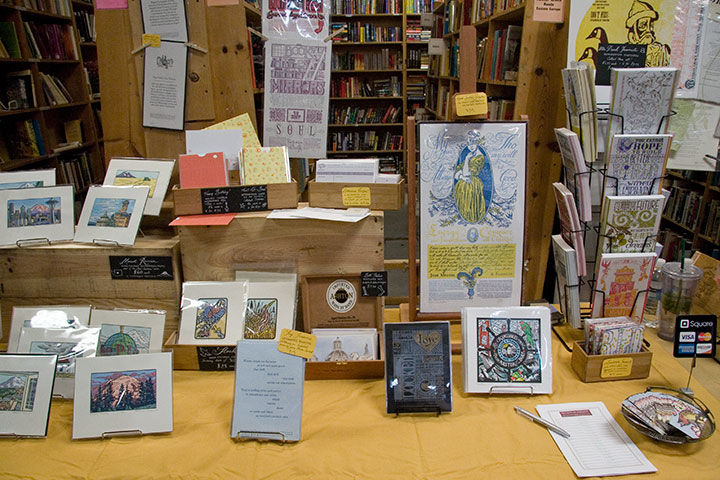
Speaking of Jessica, I think I laid eyes on her all of twice, all day. She was scurrying around and herding cats outside, while I was camped behind a steady stream of folks at our adjacent tables (thanks, y’all!). There wasn’t even room to sneak a hip shot of how many people were shoehorned in there, so the only photos I could snag were right at the beginning before folks showed up, or at the end, when people finally started to clear out.
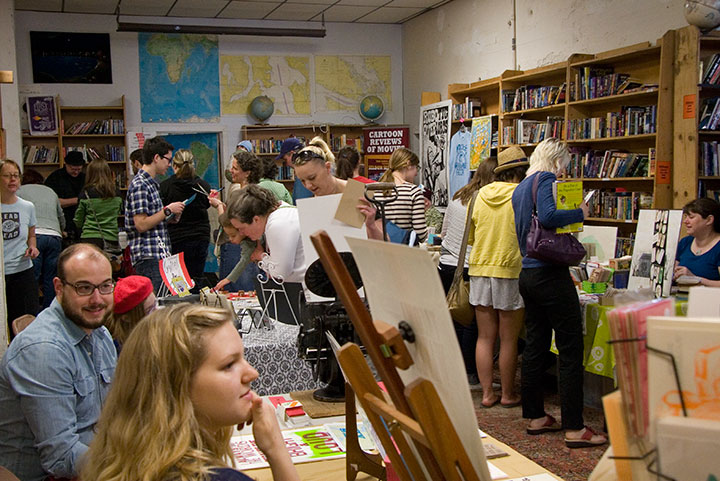
I know this doesn’t look like a big crowd, but trust me—it was a total sardine can in there. (Or clown car, if you prefer circus metaphors. I know I do.) But when the room is packed with all your favorite Northwesterners, it’s a win-win.
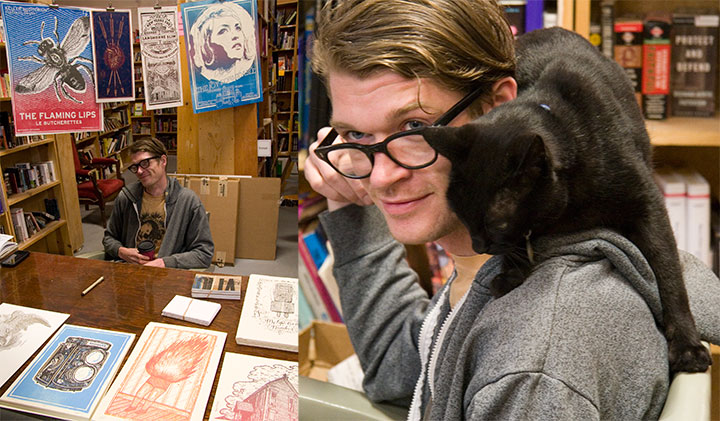
Among the talented regulars was my lovely friend Keegan (and of course, Atticus, who frequently thinks he’s a pirate parrot. Yarr!).
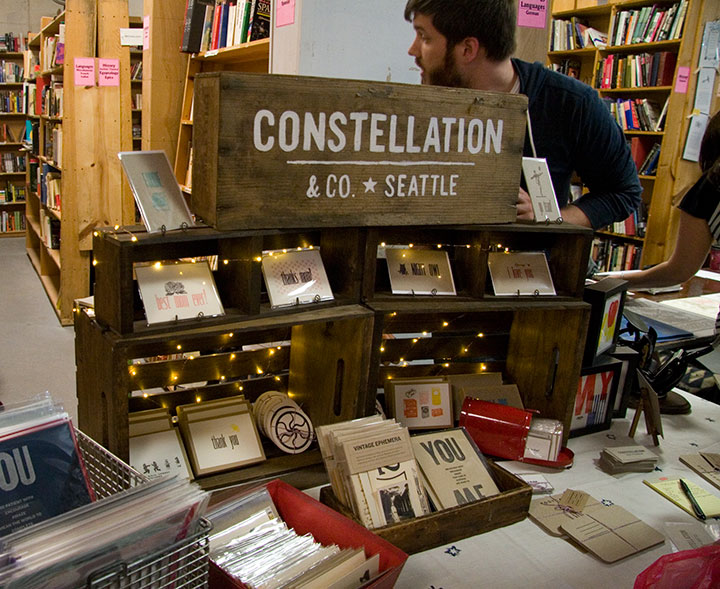
There was also a very special newcomer this year. My former student Sara caught the letterpress bug, and caught it bad. In less than three years since she took my class, she and her husband Brad (pictured) have gone from newbie nestlings to fully-fledged, successful business owners. Sigh. My kids are all grown up and making a hand-printed ruckus! It does my heart good.
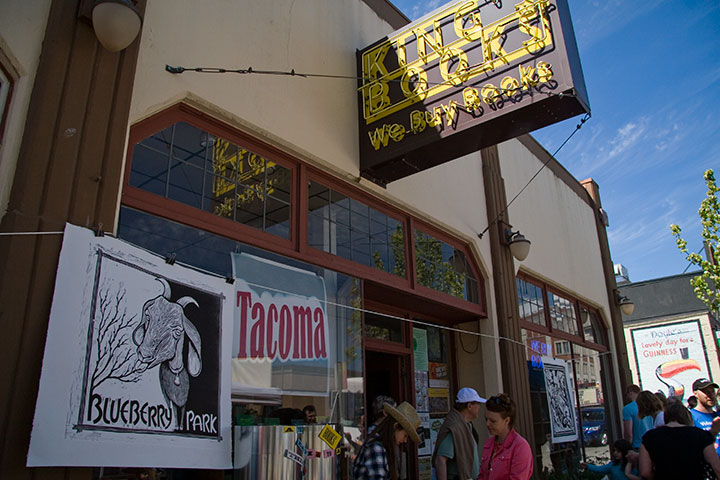
Outside, the steamroller prints were better than ever. (Special shout-out to Audra Laymon for her goatey Blueberry Park print! I think a hundred people heard me squeal when I saw it.)
Jessica and I decided to sit out the steamroller this year to make room for a few new folks, and that turned out to be a smart move. Just standing at my table for six+ hours hobbled me like an arthritic old woman—I don’t think my knee would have been up to printing. My only regret was not being able to witness much of the spectacle this year.

I did sneak outside long enough to learn that Tacoma’s own Arts Commissioners had been pressed into service (heckuva job, Scott!)—
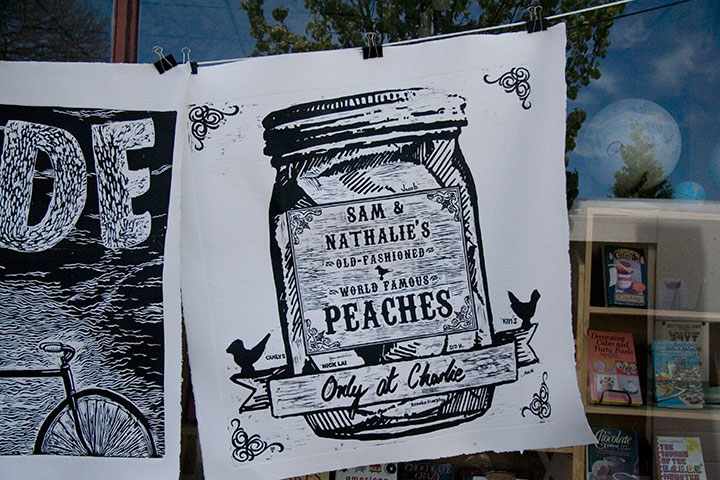
and that the print quality was the tastiest it’s ever been, thanks to some tweaked techniques Jessica gleaned from our day in San Francisco last fall.
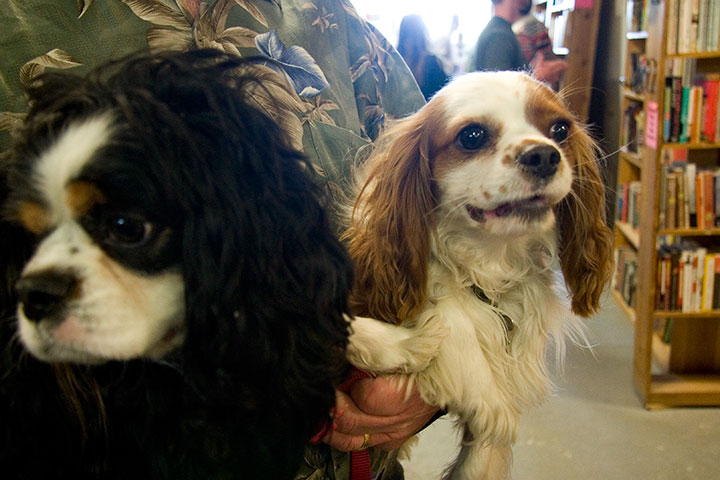
Attendance reached a new record this year—I think we’re an official Tacoma institution now. Mr. sweet pea says the count of men, women, children, babies and beasties approached the 1,000 mark!
(R.J. says: Word to your mother.)
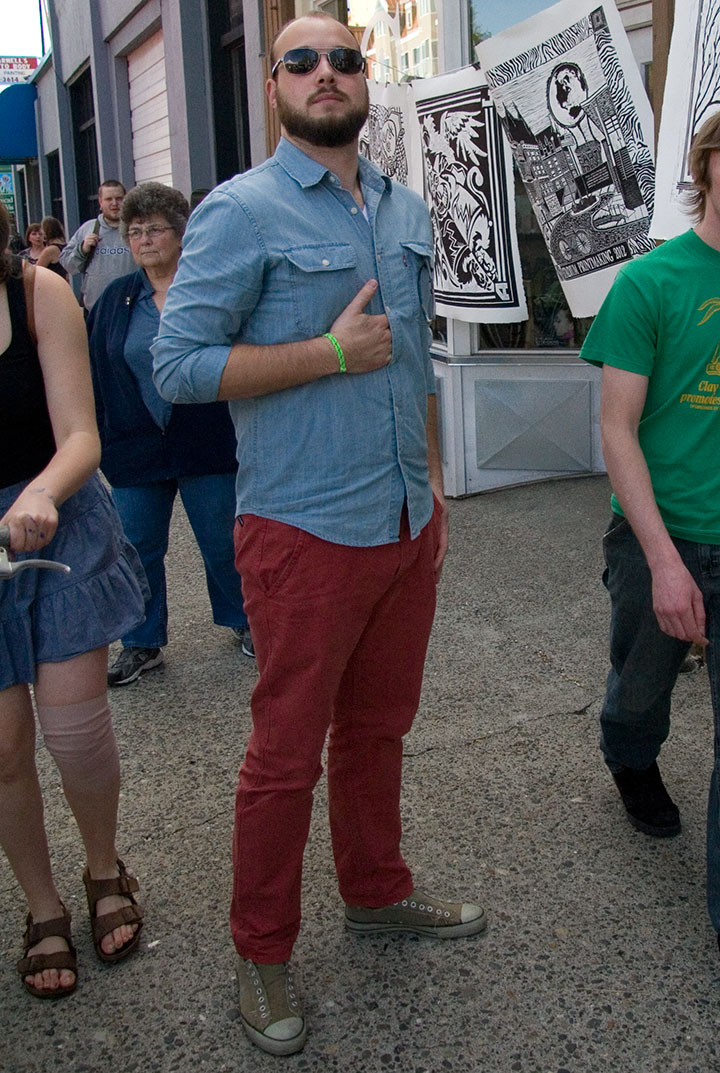
November 17th, 2010

I’ve been hemming and hawing about how best to share this thing with you. Even with Sarah’s excellent photography, it’s just a lot more difficult to explain how it works when I can’t hold the book out into space and demonstrate in real time. It’s a problem with every artist book out there—an interactive sculpture, complete with moving parts, that also happens to tell a story is just dern hard to document.
So for now, I’m going to go through the mechanics of the thing, step by step, and go into the whys and wherefores in other posts. And for those of you who might not be familiar with the term artist book, you’re going to find out really quickly that this isn’t your basic hardcover book. The definition of “artist book” is way too broad to go into within this post (click the above link to go to what I wrote on my F.A.Q. about it), but I’m hoping that by the time you get to the bottom of this post, you’ll have an idea of just how broad the term can be—and what crazy things can happily fall into the category.

Okay, let’s start with the box. When it’s all closed up, Local Conditions is almost a cube (a 10-inch cube that’s heavy enough to be hiding a sack or two of flour inside). On the topmost face of the box is the frontispiece, containing the title and a topographic map illustration of the summit of Mt. Rainier.
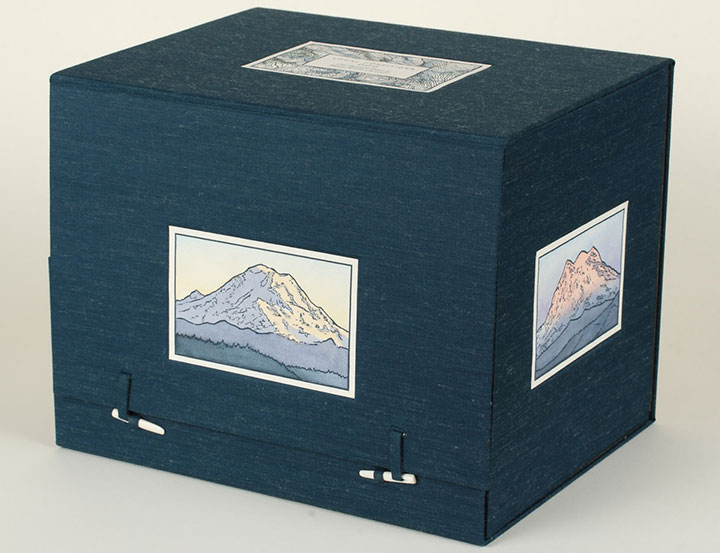
The north, south, east and west sides of the box are faced with illustrations of the corresponding faces of Rainier, each depicting the mountain at sunset.
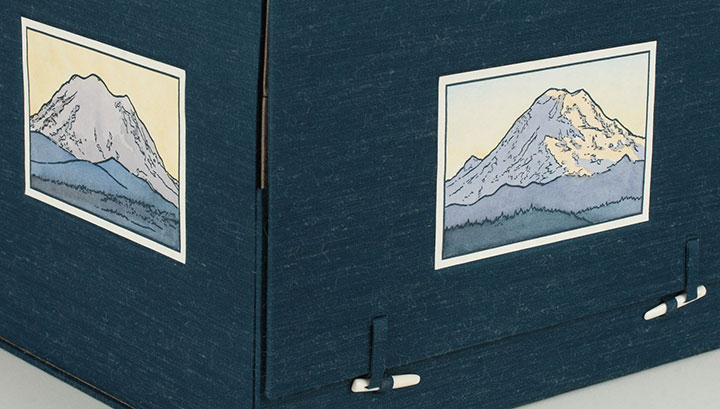
(That’s the eastern face on the left, and the north face beside it.)
Now, those two little bone clasps hold the thing together, and when you flick them out of their loops,
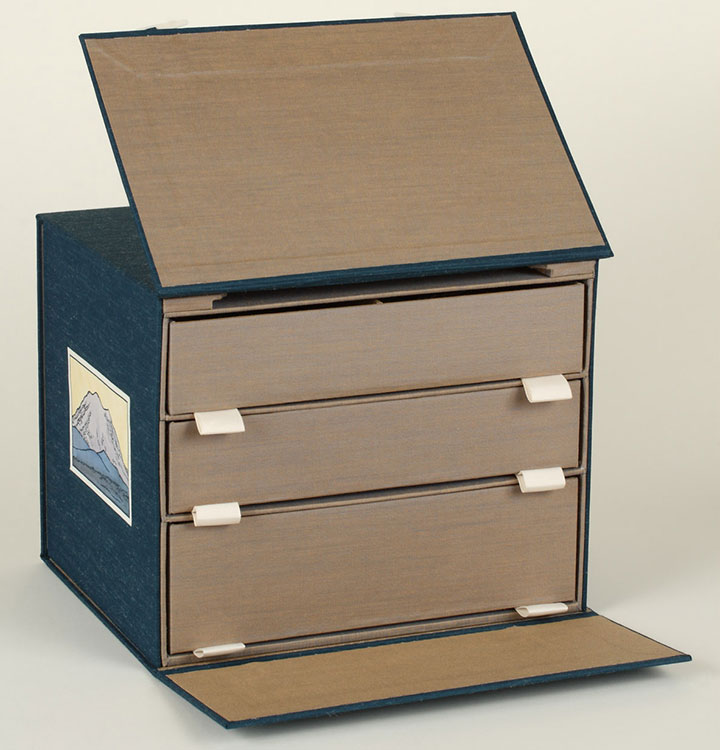
the book opens up, revealing a chest of drawers. Keep pulling on the flap you just raised,

and you’ll find that you can take the whole outer wrapper off and read the colophon (see below) printed on the inside.

The other panels on the wrapper include detailed instructions on everything the book does.

Next, let’s open the drawers—nested in the bottom one you’ll find a Viewing Box (yeah, I know … a box, within a box, within a box … sorry.) that consists of a window, a background panel, and two tabs that stick out from either side.

The tabs match up with the grooved unit at the top of the chest of drawers, and the Viewing Box slides into place.

So now the box is fully expanded, and the book is assembled for use. Now comes the fun part.
Take a closer look at the Viewing Box, and open the top two drawers.

Inside the drawers you’ll find a series of cut-out cards, each printed with a different image. These little image flats slide right into the slots of the Viewing Box,
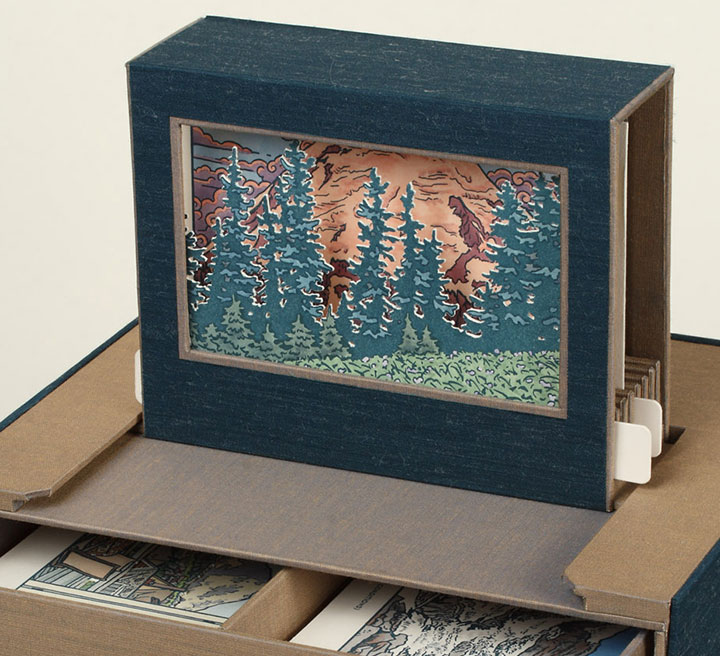
and face out the window to form an instant picture—kind of like an old-fashioned stage set.
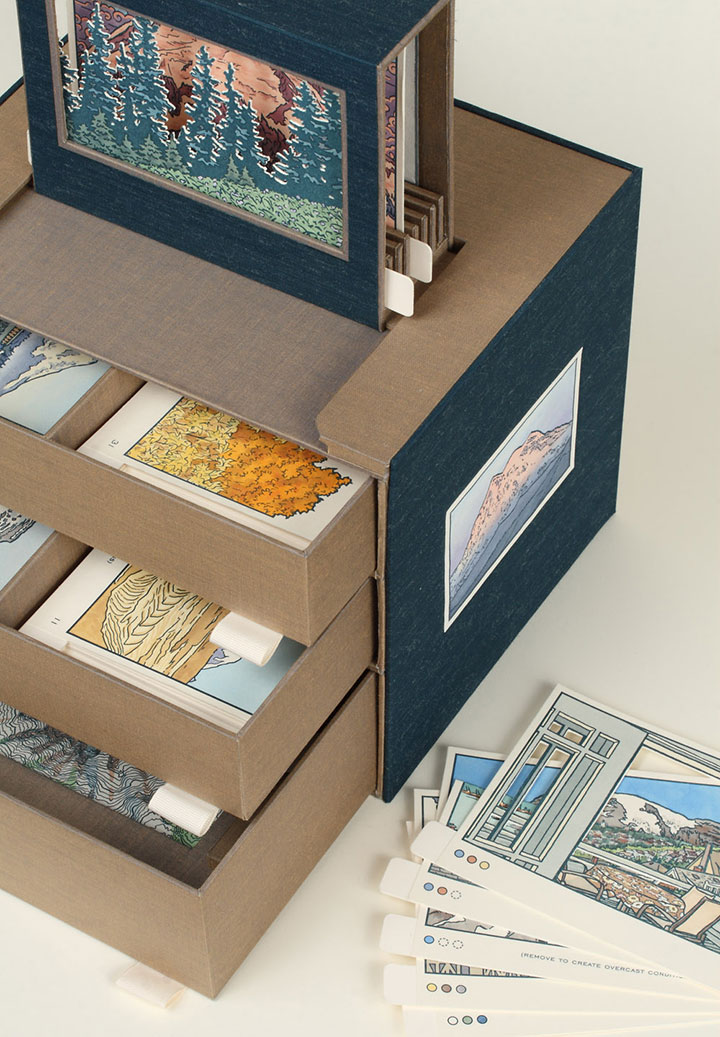
Now here’s the thing:
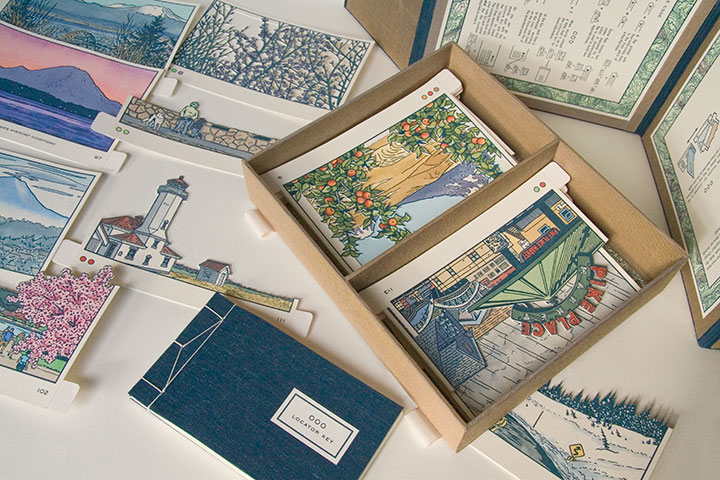
There are 120 flats to choose from. One hundred and twenty. Each one hand-printed, hand-painted, hand-cut.
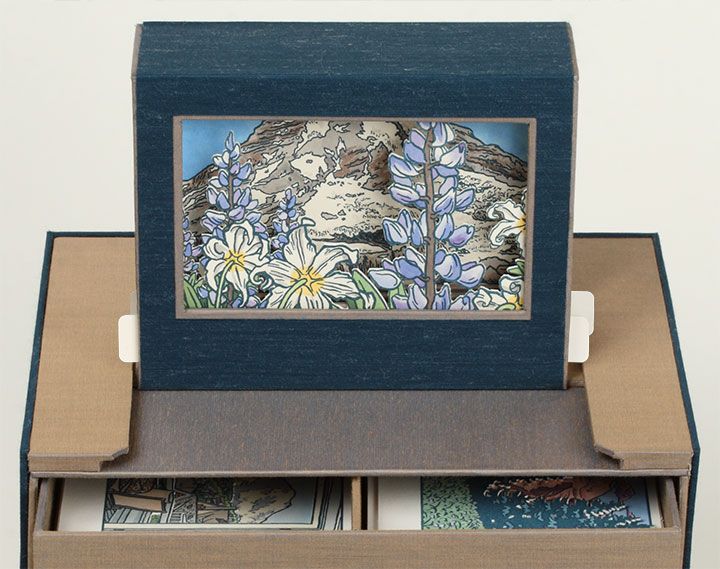
By combining, layering and switching the flats in and out of the Viewing Box, you can create seemingly endless scenes of Mt Rainier. I came up with one hundred, and documented them as part of the book (again, I’ll elaborate later), but I’m more interested in how many you can dream up.
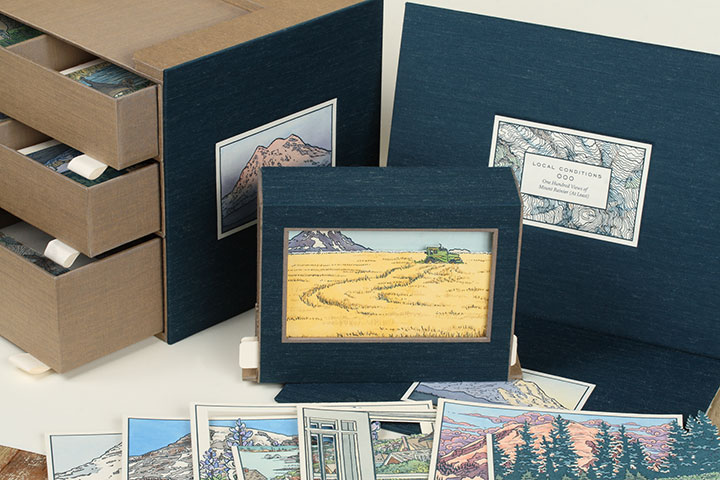
(Hint: a lot. Thousands. Millions. To be precise, 1.4 x 1015, or 1.4 quintillion, if you really wanted to push the envelope.)
• • • • • • • • • • • • • • • • • • • • • • • • • • • • • • • • • • • • • • • • • • • • • • • • • • • • • • • • • • • •
Local Conditions: One Hundred Views of Mt. Rainier (At Least)
Edition size: 26 numbered books and 5 roman-numeraled artist proofs
Book size: 10 x 8 x 8 inches when closed
Viewing window: 3 x 5 inches
Artist book consisting of viewing box and 120 image flats, illustrated and compiled from data collected in person, on location, over the course of two years. Housed in a set of drawers with nested stab-bound book and Japanese-style outer wrapper. Images and maps are hand-drawn, letterpress printed and individually hand-painted with watercolor. All image flats are hand-cut.
For price/purchase info, please contact me.
Edited to add (November 2011): As a supplement to the artist book, I also created a suite of 15 limited-edition letterpress prints, featuring some of my favorite scenes from the book. Just like the flats in the book, each print is letterpress printed and hand-painted with watercolor. You can find all 15 prints in the shop.
Colophon reads:
Japanese artist Katsushika Hokusai (1759 – 1849) is perhaps best known for his seminal works, Thirty-Six Views of Mount Fuji and One Hundred Views of Mt. Fuji. The two series of woodblock prints, published from 1829 to circa 1847, depict the sacred peak within the context of landscapes and scenes of daily life. At the heart of the series is Hokusai’s own obsession with immortality, and his fascination with Fuji’s eternal presence.
Therein lies the rub: Fuji is anything but eternal. Beyond the usual, abstract geologic transience of eroding rock and drifting continents, Fuji is an active stratovolcano. Its days—and those of the lives and lands at its base—are numbered.
Here in Washington state, just forty miles southeast of my home, lies Fuji’s taller, more volatile, American twin. Variously named Tacobet, Tahoma and Ti’Swaq’, among others, by the region’s indigenous peoples, or simply “The Mountain” by contemporary locals—its most arbitrary moniker, coined in 1792 by Captain George Vancouver, is the one that stuck: Mount Rainier.
It’s easy to forget Rainier’s impermanence. It has presided over thousands of years of indigenous culture, followed by the encroachment and permanent occupation of white settlers. It oversaw the construction of the Northern Pacific Railroad, the fever of the Klondike Gold Rush, the splendor of the Alaska-Yukon-Pacific Exposition. It stood in judgment while the American descendants of Hokusai’s countrymen were imprisoned beside the wooden-frame rollercoaster of the Western Washington Fairgrounds, at the internment center nicknamed Camp Harmony. And it has watched the rise and decline and rise again of Tacoma, the City of Destiny lovingly misnamed in its honor.
Yet all the while, Rainier has changed as much as the tableau at its feet. Its volcanic restlessness shifts its form, as our capricious Northwestern weather masks its appearance. It hides, or dominates, depending on the time of day or year. Even we have proved a catalyst, as our warming climate chases its alpine glaciers into retreat at the speed of industry.
And one day—whether tomorrow or in a million years, in an explosion of ash or by the erosion of time—Mount Rainier will disappear completely. I can’t begin to predict the future, but I can attempt to capture the present moment. One hundred present moments, to be exact. If nothing else, Local Conditions is a reminder of the lesson of this place: that here in the Ring of Fire, we never see the same Mountain twice.
* * *
Illustrated, designed, printed and bound by Chandler O’Leary, through freak snowstorms, record heat, and a thousand gentle rains in Tacoma, Washington. Each of the book’s 120 image flats is illustrated and compiled from sketches, photographs and data collected in person, on location, from September 2008 to October 2010. All text and images were letterpress printed in Hokusai’s indigo ink, down the street at Springtide Press. Images and topographic map patterns are hand-drawn and watercolored.
For making it possible to turn this crazy idea into an even crazier reality, many heartfelt thanks to Jessica Spring, Sarah Christianson, the Tacoma Arts Commission, the University of Puget Sound Collins Memorial Library, and the Book Arts Guild. Thanks also to the weather, for always, despite a notorious reputation, seeming to hold just long enough for me to grab the camera and jump in the car.
Produced with the support of a Tacoma Artists Initiative Program grant from the City of Tacoma Arts Commission.
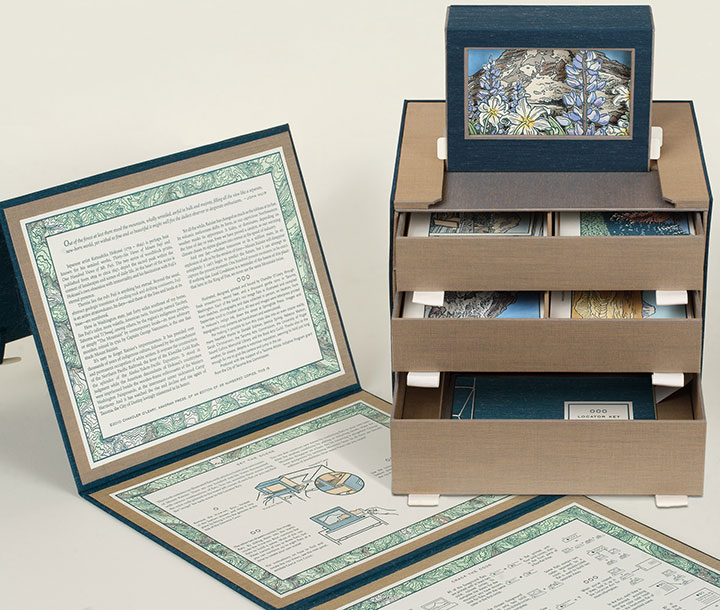

![Chandler O'Leary [logo]](https://chandleroleary.com/wp-content/themes/chandleroleary/images/logo.png)





























